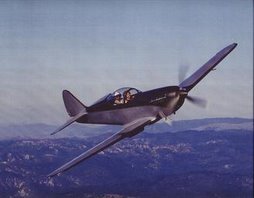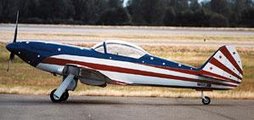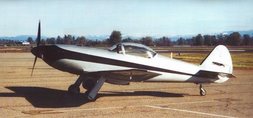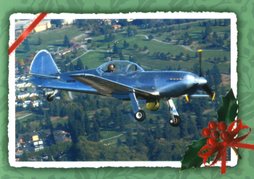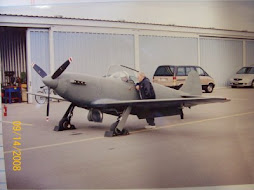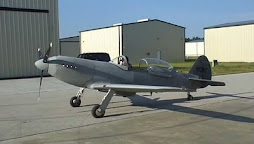As promised in the last update, here is the blog update for the 4th quarter of 2025. Here's what I have for this update:
1. Builder Updates:
1.A Bryan (Kit #007);
1.B. Francis (Kit #11);
1.C. Vaughn (Kit #13);
2. Tailwheel Strut for Francis;
3. Other Side Projects:
3.A. New Property Work;
3.B. Kubota Repairs;
3.C. Wood Stove;
3.D. Radius Turning Tool.
Same as with the last update, I did not really accomplish any Prowler related work since the last update. The list of distractions is long. The main one has been helping the oldest daughter tame a "fixer-upper" piece of property that she and her new hubby bought. The property was trashed, burned out and neglected for 20+ years. Of course, that has led to some more projects (like I need another project.... or 10)! Anyway, I am trying to get my plate cleared by the end of the year so that I can begin to focus on the Prowler Aviation projects again in the new year - at least, that's my resolution. We'll see how long I can keep to it.
For now, on the with update.
1. Builder Updates: - The most active Prowler builders right now are: Bryan, Francis and Vaughn. This past year, Bryan has set out to design a new FWF package for his Prowler after finally ditching the original plan to build a DeltaHawk Diesel FWF setup. He has been working with Stuart at AutoPSRUs and his reduction gear and adapter are currently in the works. Francis continues his rapid and steady progress on building their Prowler kit. And, after purchasing a partially completed kit a few years back, Vaughn has been making steady progress on building his Prowler - currently his focus is on the engine compartment and working with a vendor to build up a Mazda rotary engine FWF solution. Here's more:
1.A Bryan (Kit #007) - I asked Bryan for an update on his Prowler work. Here is the narrative that he sent me:
Let's start with an update of the engine. Here's a picture of all of the pre-prepared parts that I built to supplement the four-cylinder turbo Honda K20. I added cooling fins and one additional quart capacity to the oil pan. You can see the turbo exhaust and the water to air intercooler which attaches below the engine.
All the stuff is still sitting here because my engine is still in Texas. Stuart (AutoPSRUs) has been updating me quite frequently. They're two main issues holding up that project. One, the machinist who made all of the reduction gears was a relatively new guy and made them in error. After a bunch of back-and-forth as to who was at fault it obviously wasn't Stuart's. Anyway, they're making new gears.
The second problem arose because the CNC machine which is going to make the bell housing which attaches the PSRU to the engine required a substantial amount of upgrades and repairs. With that completed the next problem occurred when the software program kept getting confused. The Engine sits in the engine bay at a 10° tilt to starboard exactly the way it was in the automobile, however, the PSRU is attached vertically to the airframe. After several test trials, it appears as though they finally got the software to figure all this out and we're still waiting to put the 134 pound block of aluminum under the cutting tool. That process will remove all but 12 1/2 pounds of metal when the bell housing is complete. It will take a full week or so of the machines time to do the job. I doubt it will get done before January or February 2026.
I got frustrated with all of my supposed aircraft maintenance friends when no one would come by to assist me with riveting the patch over the fuselage dent damage. I tried unsuccessfully to massage out the impact point but the metal was over stretched and would not re-conform. I finally convinced my wife that she could operate the rivet gun without too many tears. The repair turned out exceptionally well and all of the lines are straight with an uninterrupted reflection. After paint, I don't think anybody will know that anything ever happened in the first place.
[Sidebar: This repair was the result of damage I covered in this update earlier this year.]
After an almost 10 month production delay, I finally got my new hydraulic motor for the landing gear system. It went in without a hitch, however, not having the gear attached to the hydraulic cylinders I couldn't get the system to function correctly. For some reason I discovered the tail wheel hydraulic cylinder had been hooked up backwards as that cylinder needs to extend while the main gear cylinders retract in order to get the gear to go into the wheel wells. With that situation rectified I was able to get a good 10 cycles on the landing gear with the electric up locks functioning very well.
The next morning there were pools of hydraulic fluid on the floor and for a good reason. The last time I serviced, the hydraulic cylinders was over 15 years ago. It became obvious that I would need to pull all of the cylinders and replace the packing where the rod extends out of the cylinder. I'm in the process of doing that now. One item of note is that with the 12 V system installed the gear takes approximately 21 seconds to make a full retraction sequence happen that's about seven seconds longer than the 24 V motor I had previously installed unfortunately I can't locate the video, but I'll make a new one for the next update.
Since the PSRU delay has been extensive I elected to initiate a tail to firewall restoration process. I have gone through and removed every system out of the fuselage and rebuilt, refurbished , repainted or reconfigured each system into a better circumstance. Here is the new avionics bay.
New keel beam and cockpit side wall framing along with sub systems installed.
The firewall required a complete remake because all the penetrations will be different (from the old diesel engine plans). Coolant lines, electrical cables, controls and the like will all be in different positions. This is about as far as I can go until such time as I get my engine back because the earlier firewall is attached to the engine in Texas at the moment.
The new 12v flap motor and motors for the cowl flaps (radiator doors) came and installed nicely. I did have to modify the flap motor bracket by lengthening it but the system functions just like the earlier version. This motor has a potentiometer built in so I was able to do away with all the external sensors I had previously needed to use to indicate the position of the flaps.
One of the unexpected issues that came up was the autopilot servos had to come out and be reprogrammed at Dynon. The software program timed out and they needed new code to talk to the new autopilot control head. It was a full day process just to install the unit as it is buried in the wing just inboard of the port torque box. Fortunately with the radiator and its housing removed it made the process a little easier.
Thank you for the update, Bryan! We look forward to seeing your new AutoPSRU FWF package together and on your Prowler!
1.B. Francis (Kit #11) - Well, what else can I say.......He's killin' it! You will see below that he has reached the point where he pretty much has the entire aircraft framed up from firewall to rudder spar! Here is his work on the luggage compartment area:
For whatever reason, his luggage compartment floor was interfering with the main elevator push-pull tube. He solved the problem by raising the aft end of the floor slightly - making room for the tube through the full range of motion:I believe this was one idea he had for making a small "tunnel" for the elevator tube to pass through in the luggage compartment floor - if he had installed it flush with the tops of the longerons (but, opted to incline the luggage compartment floor instead):A little more luggage floor fit-up work:
Here's a little larger overview of the aft empennage alignment and straightening:This looks like his final finish of the luggage compartment floor:Great idea! He's using long zip ties to hold tension on the longerons to keep them in position:Next, I believe that this is the hole for the push-pull tube that extends from the aft of the joystick torque tube to the idler that mounts on the back side of this bulkhead:Here is that idler mounted on that fuselage former at the aft of the cockpit:Here is some of the work on his tailwheel compartment and the TW operating linkages:He appears to have all of the linkages installed for the TW strut:
This video is a good overview of the TW strut work Francis did:It looks like it will work great, once he gets a TW strut! More on that below.
Here is the work Francis has been doing to fit and fabricate the elevator control torque tubes at the horizontal stabilizer:
I believe this is an elevator spar and he is doing some work to get the hinge holes laid out properly:I think this was when Francis had to straighten out, and re-drill some of the hinge points for the elevator spar. He mentioned that the spar was slightly bowed, and it pulled the ends of the spar forward and that led to mis-alignment of the two outboard hinges. Here are the spars in a drill jig/fixture that he has made up:Also, he found that his elevator torque tube brackets had the angles mis-aligned between the brackets that mount to the elevator spars and the other half of the bracket that mounts the two elevator halves together (and to the push-pull tube). So, he cut them apart:Then, he made up an inside sleeve, "re-clocked" them (for lack of a better term) and re-welded them the way that he needed them to be:Here is his work on the elevator spar for fabricating and mounting the pad for the trim tab actuator to mount onto:Here's the bracket that mounts to the inside of the spar:The MAC servo test fitted in place:Bringing all the parts together - Actuator bracket, servo bracket and spar sandwiched between them:Laying it out on the elevator skin:
Next, it's on to the other end of the plane. Here is some of the fabrication work to mount his firewall:Fabricating the actual firewall, itself:
And, here it is mounted in place:DANG! That Prowler is REALLY starting to take shape!Looking great!I looked back and it was almost exactly one year ago that I created CAD drawings for the fuselage jig and sent them to Francis. In that time, he has built that jig, mounted the center section of the plane in it, and built out the fuselage from the firewall to the rudder spar. That is actually quite a lot to accomplish. He has gotten a lot done in this year. Outstanding work, Francis! As always, thank you for your updates, pics and vids!
1.C. Vaughn (Kit #13) - Vaughn has been working hard at learning a lot about sheetmetal and becoming a real metalsmith! He has mastered the english wheel and done a great job making a set of engine cowling panels for his Prowler. Here is an inside-out shot near the firewall:He has finished the lower engine compartment panels - including the lower center panel with the airscoop:
Here are his "elephant ears" ahead of the leading edge roots:
And, the same - with the skins on:Getting ready to rivet them up:They look great! Vaughn's engine compartment is a few inches longer than the original Prowlers because he is putting a Mazda rotary engine in his plane. It's a bit lighter and the engine has to sit farther forward for weight & balance to work out:Than looks so nice!Here is his work on the top of the engine compartment:It's looking great, Vaughn! Thanks for the pictures and the updates!2. Tailwheel Strut - My only real contribution to the Prowler world this quarter was to make (or find) a TW strut for Francis. He didn't get one in his kit and is at the point where he needs it. I do not have any in inventory and I initially told him that I'd have to make one for him. It is doubtful that I'd even have that strut made yet, and I didn't want to hold up the excellent progress that Francis is making.
Then, I remembered that Bryan had purchased a 2nd secondhand kit in the past few years. So, I texted him to see if he had an extra TW strut that I could "borrow" for a few months......or, so!?!? He texted back this picture and said: "You mean like this?":Yes, sir! That'll do! So, Bryan shipped that strut to me, and I got it to a third party shipping place that was already setting up the shipping of another kit to Robert (who is a friend of Francis). It's now on it's way to Francis as I write this up. He should have it in the next few weeks.
The plan is for me to machine a new TW strut for Bryan in the next few months to replace the one that he sent to me. This will keep me from delaying Francis while I figure out how to fabricate a TW strut. It's one of the few parts of the plane that I haven't made yet. But, now that I have the old LeBlond lathe restored, it'll work great for making a part that size. My old lathe would have been too small. So, in the next few months I will be getting tooled up and trying to turn out one of those TW struts.
Thanks for the help, Bryan!
3. Other Side Projects
3.A. New Property Work - I am gonna try to not get too "wordy" about all of this. But, helping my daughter and son-in-law with this property that they got has taken up a bunch of my time lately. Here is a few "before" pics from the MSL listing:
Note the overgrowth of blackberry canes and just general neglect. Now, compare that to this "after" pic that represents about 2 weeks of cutting and burning a lot of brush and garbage:In this pic, you can see a retaining wall that I built between the large pine trees to make a flat pad at the top of the property. That pad makes a large flat space that they will be able to move her travel trailer onto and have some space to park, etc.:Here's an shot of the "front" of the burned out single-wide after a lot of cleanup:Here is the pad for the travel trailer and parking. It's hard to get a sense of size from the pic above. But, that pad is about 50 ft along the right edge and about 30 ft across the back.
Before we started cleaning up the property, this is one of the abandoned RVs that was parked in that same area of where I made the flat pad above. It was not level and this old RV was perched there kinda precariously.
So, one of the first orders of business with this clean-up was to tackle that 5th wheel RV. They needed rid of it, and I've been wanting a larger, 5th wheel utility trailer. So, I agreed to take the trailer frame if they helped me tear it down to the deck. This is after the walls were gone and we were cleaning up the final crap into the dumpster on the left:After we had it ready to roll, I used her truck to pull it down to my shop so that I could continue to covert it to a utility trailer. This was a pic I took on the drive home:Once home, I continued to strip it down to the steel frame:There was a nice Onan 220Vac RV Genset that was mounted in the front of this RV. I yarded that out and will eventually be working on that to get it running. First, I will have a fair amount of steel work that I'll need to do to make this trailer more efficient and better looking. More to follow.
3.B. Kubota Repairs - After using my daughter's truck to pull the RV trailer project down to the home shop, I decided that this would be a great opportunity to use her truck to pull my tractor back up to her property to help with the cleanup, etc. She has a 3/4 ton diesel truck and I only have a 1/2 ton gasser (at home) - it pulled the tractor so much easier than with my truck. Here's the day I got up there with the tractor:On the second day there, I was packing stuff down into the dumpster with the bucket and somehow, when I raised the bucket one time, the front of the tractor came down and the muffler hooked something on the dumpster - the result was total failure of the exhaust manifold:Ugh!! I removed the muffler and was able to still use the tractor with the broken manifold on it for a few days - until I planned to head back home again.
While I was working up there, I also found out that there were two hydraulic cylinders on the scraper box that were leaking pretty badly. Here's one of the two that I pulled off the tractor to bring back tot he shop to get re-sealed:So, on the next trip home, I brought both cylinders and the broken exhaust manifold to the shop. I repacked the hydraulic cylinders and did some high nickel rod repairs to the exhaust manifold:I've had pretty good luck using the high nickel rod and pre-heat on cast iron repairs. This (and the wood stove door repair) both turned out pretty good - for a "not formally trained" rod burner like me!
Since I wasn't sure that I'd be able to repair the exhaust manifold in time for the next trip to the property, I researched a replacement manifold for the tractor. I found one online for a pretty reasonable price - so I got it:Now, I have the new manifold installed on the tractor. But, if I ever accidentally break the manifold off again - I now have the repaired one that I can put right on!
3.C. Wood Stove Restoration - On my 1st trip to begin helping with the property we found an old wood burning stove sitting out in the wild. It had been abandoned because it had one of the hinge arms broken off of the door. It was in pretty ruff, but I thought it was repairable condition. I had an idea, made a plan and brought the old stove home to the shop.
The first step of the repair was to see if I could weld the hinge arm back onto the door. Here it is after a mostly successful repair to the upper right hinge arm:The door temporarily test fit back on the stove:With the door fitted and the hinge holes re-bored, the stove went on its back to remove all the broken fire brick, rotted angle irons, and general rust, dust and debris:Here, I am installing the new fire brick:Sitting out in the elements of Oregon for years took a toll on the feet. They were made from 2" balls of aluminum that were cast onto a 1/2"-13 steel bolt. But, the aluminum had corroded and pitted pretty substantially - especially on the back feet. Here is one of the worst ones in the lathe:To try to clean them up, I put them in the lathe and turned down a small band near the middle of the balls until I got a mostly clean surface:But, I wanted them to be round again. I was going to need to get a tool that could turn a large radius on a part in the lathe. I will cover more on getting the radius tool set up in the lathe in the next section, but here is one of the feet getting cleaned up in the lathe and getting turned down to a round shape again:
Here are all of the feet after getting cleaned up (now just a bit smaller diameter than before):At this point, 3 thing remained to compete the restoration: exterior paint; weld on angle irons to hold the tops of the fire bricks; and then install the seal around the stove door. Here is a peek at all three of those:I welded the sections of angle iron you can see around the tops of the fire bricks inside the stove. Then, I got some high temp, flat black paint put on the exterior. When the paint was dry, I rolled the stove on it's back again to install the smoke seal around the door. It's a high temp, woven fiberglass rope that you glue into the channel with some kind of high temp mastic supplied with the seal. It turned out pretty good, I think!?!?
And, here is the end result:I am going to give this back to our daughter and her new husband as a combination "property warming gift," a wedding gift and a Christmas gift this year. I'm hoping that they will get many years of good use out of this stove. I am also hoping that because it was on the property they bought it and because I restored it for them, it will have some sentimental value to them as well.
3.D. Radius Turning Tool - Once I realized that I needed a radius turning tool for the lathe in order to fix the feet on the stove I began to search for the right thing. There are many different styles and designs of these tools. Here's the one I chose:The problem was, it was designed for a different style lathe - so I was going to have to made an adapter for it to fit my lathe. It was too big to fit in place of the normal tool holder, so I had to pull off the entire compound from the lathe and put the new tool where the compound slide mounts. So, the first step was to removed the compound slide altogether:Fortunately, on my lathe, the mount for the compound slide is pretty simple. All I had to do was find a block of aluminum thick enough to get the cutter on the radius tool to be the exact same height as the point on the tool you see here in the headstock:After making a few measurements and a crude drawing, I rummaged around a bit, and found this in my horde:I chucked that stock in the lathe and started to machine the adapter. These are the very first chips that I've made with my "new" 83 year old Leblond lathe since finishing the restoration. This was satisfying! It worked great:Starting to turn the stock down to the correct diameter for the adapter:In the end, here is what I came up with for the adapter:
The radius tool mounted to the top of the adapter:Finally, the adapter and tool mounted to the lathe and doing some first test cuts:As you saw above, I was able to turn down all the feet for the stove and the tool worked very well. Now, that I have this tool set up, I will be able to use if for any other jobs that may come up. It worked great!
A Couple Final Things:
I mentioned that I have a few other side projects spawned from the kids' property work. Like, Onan RV generators from each of the abandon rigs on the property. Here's a 4.0kW single phase 120Vac gen that came out of the abandoned motor home:As you can see, I'm already into this project. So far, I've found it has compression, it has a clean carburetor, it makes a really weak spark and I still have not investigated the fuel pump. This is going to be a "flipper" that I get running and sell. It is only a single phase 120Vac genset and I have several of these already.
And here's a 4.5kW single phase 220Vac gen from the 5th wheel RV:Long term, this is going to be a "keeper." The plan is to get running and then I will take it back to the kids' property and install it for them. Since it is a 220Vac gen, it can be permanently installed on the property to work as a backup generator if they have a power outage. It will be big enough to run their well and a few other loads. It seems to be in decent shape and was pretty well taken care of. More to follow.
So, when I said that a project or 10 to my plate, I really wasn't kidding! Anyway, that's all for this update. Thanks for following along with all my escapades and side journeys. I promise that I am working hard to get back on track with the Prowler stuff soon.
HAPPY HOLIDAYS AND MERRY CHRISTMAS!















































.jpg)





































